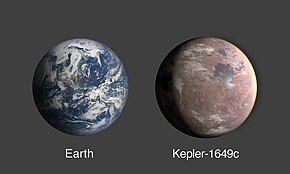Kepler-1649c
 | |
| Discovery | |
|---|---|
| Discovered by | Kepler spacecraft |
| Discovery date | 15 April 2020 |
| Transit | |
| Orbital characteristics | |
| 0.0649[1] AU | |
| 19.5352551±0.0001018[1] d | |
| Inclination | 89.65 |
| Star | Kepler-1649 |
| Physical characteristics | |
| 1.06+0.15 −0.10 R🜨 | |
| Mass | 1.2[2] ME |
| Temperature | 234 ± 20 (est.) K |
Kepler-1649c is an exoplanet orbiting the M-Type red dwarf star Kepler-1649, about 300 light-years from Earth.[3] In 2020, Jeff Coughlin, the director of SETI's K2 Science Office, described it as the most "similar planet to Earth" found so far by the Kepler Space Telescope.[4] The planet was originally deemed a false positive by Kepler's robovetter algorithm. The Kepler False Positive Working Group published its recovery on April 15, 2020.[5][6] Its first scientific description was published in The Astrophysical Journal Letters, with first author Andrew Vanderburg, in April 2020.[5][7]
Characteristics
Mass and orbit


The exoplanet was identified as a rocky planet by NASA[8] and is very similar to Earth in terms of size, with a radius 1.06 times that of Earth.[5][9] Kepler-1649c takes only 19.5 Earth days to orbit its host star Kepler-1649, an M-Type red dwarf.[10] It orbits within the habitable zone of its star system.
Climate
Very little is known of Kepler-1649c's climate.[5] It receives fully 75% of the light from its host star that Earth receives from the Sun; therefore, depending on the atmosphere, its surface temperature may be similar enough to the temperature of the Earth that liquid water may be present.[4] It is unclear what the composition of Kepler-1649c's atmosphere is.[8]
Host star
Kepler-1649 is a type-M red dwarf star estimated to be roughly ¼ the radius of our Sun.[10] with only two confirmed planets in its orbit, the other being Kepler-1649b.[11] Kepler-1649b is similar to Venus from our own solar system in two ways. First, Kepler-1649b and Venus both have orbits roughly half the radius of the next known planets (Kepler-1649c and Earth respectively). Second, both of them are of similar size.[8]
Habitability
While the exoplanet does orbit within its star's habitable zone, due to the lack of information on the exoplanet's atmosphere, it is unclear if Kepler-1649c can sustain liquid water on its surface. As of 2020, no solar flare-ups have yet been observed from the host star; nonetheless, scientists believe that such stars are prone to frequent solar flare activity, and that such flares may have stripped the exoplanet's atmosphere and hindered the prospect of life.[3][8]
See also
References
- ^ a b "NASA Exoplanet Archive – Planet Candidate Overview – Kepler-1649c". Retrieved 27 April 2020.
- ^ "ExoplanetKyoto - Kepler 1649c". www.exoplanetkyoto.com. Retrieved 1 May 2020.
- ^ a b April 2020, Mike Wall 15. "Newfound alien planet may be most Earth-like yet". Space.com. Retrieved 2020-04-16.
{{cite web}}: CS1 maint: numeric names: authors list (link) - ^ a b Georgiou, Aristos (16 April 2020). "Potentially habitable exoplanet that is Earth-like in size and temperature was discovered 300 light-years away". Newsweek. Retrieved 17 April 2020.
- ^ a b c d Vanderburg, Andrew; Rowden, Pamela; Bryson, Steve; Coughlin, Jeffrey; Batalha, Natalie; Collins, Karen A.; Latham, David W.; Mullally, Susan E.; Colón, Knicole D.; Henze, Chris; Huang, Chelsea X. (2020-04-15). "A Habitable-zone Earth-sized Planet Rescued from False Positive Status". The Astrophysical Journal. 893 (1): L27. arXiv:2004.06725. Bibcode:2020arXiv200406725V. doi:10.3847/2041-8213/ab84e5. ISSN 2041-8213.
{{cite journal}}: CS1 maint: unflagged free DOI (link) - ^ Strickland, Ashley (15 April 2020). "New potentially habitable exoplanet is similar in size and temperature to Earth". CNN. Retrieved 17 April 2020.
The study published Wednesday in The Astrophysical Journal Letters.
- ^ "Texas-Led Team Finds Earth-Sized, Habitable Zone Planet Hidden in Early NASA Kepler Data". University of Texas at Austin. Retrieved 2020-05-18.
- ^ a b c d "Earth-Size, Habitable Zone Planet Found Hidden in Early NASA Kepler Data". Exoplanet Exploration: Planets Beyond our Solar System. Retrieved 2020-04-16.
- ^ Carter, Jamie. "Long-Dead Telescope Detects 'Most Similar Planet To Earth Ever Found' In A Star's 'Habitable Zone'". Forbes. Retrieved 2020-04-16.
- ^ a b McDonald, Rebecca (April 15, 2020). "Dedicated Team of Scientists Discover Habitable-Zone Earth-Size Planet in Kepler Data". Seti Institute. Retrieved April 17, 2020.
{{cite web}}: CS1 maint: url-status (link) - ^ "Exoplanet-catalog". Exoplanet Exploration: Planets Beyond our Solar System. Retrieved 2020-04-16.




